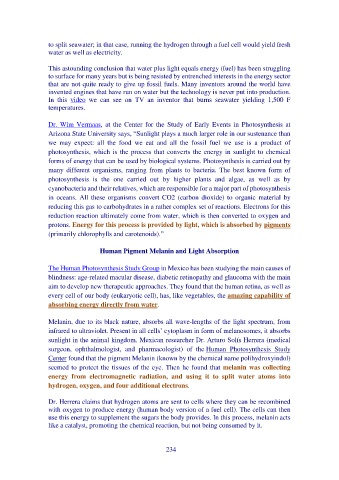Page 234 - Wasserstoff Medizin
P. 234
to split seawater; in that case, running the hydrogen through a fuel cell would yield fresh
water as well as electricity.
This astounding conclusion that water plus light equals energy (fuel) has been struggling
to surface for many years but is being resisted by entrenched interests in the energy sector
that are not quite ready to give up fossil fuels. Many inventors around the world have
invented engines that have run on water but the technology is never put into production.
In this video we can see on TV an inventor that burns seawater yielding 1,500 F
temperatures.
Dr. Wim Vermaas, at the Center for the Study of Early Events in Photosynthesis at
Arizona State University says, “Sunlight plays a much larger role in our sustenance than
we may expect: all the food we eat and all the fossil fuel we use is a product of
photosynthesis, which is the process that converts the energy in sunlight to chemical
forms of energy that can be used by biological systems. Photosynthesis is carried out by
many different organisms, ranging from plants to bacteria. The best known form of
photosynthesis is the one carried out by higher plants and algae, as well as by
cyanobacteria and their relatives, which are responsible for a major part of photosynthesis
in oceans. All these organisms convert CO2 (carbon dioxide) to organic material by
reducing this gas to carbohydrates in a rather complex set of reactions. Electrons for this
reduction reaction ultimately come from water, which is then converted to oxygen and
protons. Energy for this process is provided by light, which is absorbed by pigments
(primarily chlorophylls and carotenoids).”
Human Pigment Melanin and Light Absorption
The Human Photosynthesis Study Group in Mexico has been studying the main causes of
blindness: age-related macular disease, diabetic retinopathy and glaucoma with the main
aim to develop new therapeutic approaches. They found that the human retina, as well as
every cell of our body (eukaryotic cell), has, like vegetables, the amazing capability of
absorbing energy directly from water.
Melanin, due to its black nature, absorbs all wave-lengths of the light spectrum, from
infrared to ultraviolet. Present in all cells’ cytoplasm in form of melanosomes, it absorbs
sunlight in the animal kingdom. Mexican researcher Dr. Arturo Solís Herrera (medical
surgeon, ophthalmologist, and pharmacologist) of the Human Photosynthesis Study
Center found that the pigment Melanin (known by the chemical name polihydroxyindol)
seemed to protect the tissues of the eye. Then he found that melanin was collecting
energy from electromagnetic radiation, and using it to split water atoms into
hydrogen, oxygen, and four additional electrons.
Dr. Herrera claims that hydrogen atoms are sent to cells where they can be recombined
with oxygen to produce energy (human body version of a fuel cell). The cells can then
use this energy to supplement the sugars the body provides. In this process, melanin acts
like a catalyst, promoting the chemical reaction, but not being consumed by it.
234

